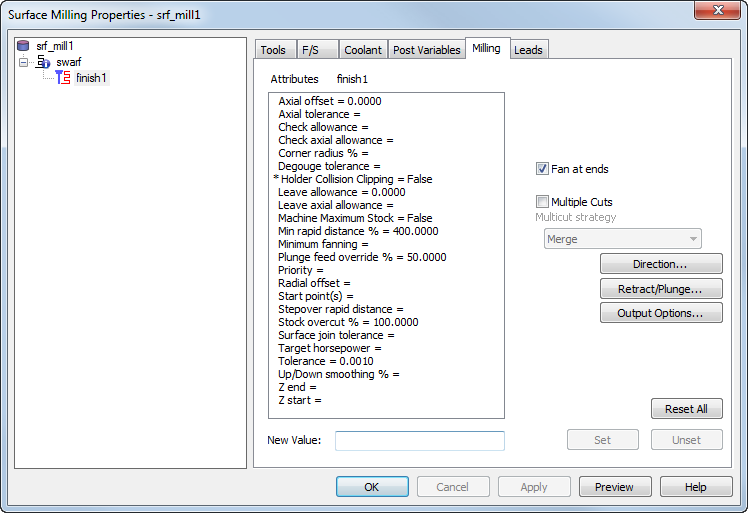
5-axis position menu — There is often an alternate orientation option for accessing a face. Select from:
- Standard — The default orientation.
- Alternate — The alternative orientation to the default.
- Use Post Preference — Uses the position (Positive or Negative) set in XBUILD in the Five Axis dialog for the Preferred orientation of the primary rotary axis option.
- Use Axis Limits — Allow FeatureCAM to select the orientation that best fits within the axis limits set in the MD file.
Axial offset — This attribute offsets the lowest position of the toolpath along the tool axis. Positive numbers offset the toolpath towards the tool holder, negative numbers away.
Axial tolerance — This helps to stabilize the tool axis and reduce tool load.
Check allowance — Enter the minimum distance that you want to leave around check surface(s). If left blank for a roughing pass, the Finish allowance value is used. If left blank for a finishing pass, the Leave allowance value is used. You can enter a positive or negative value. Set Check surfaces on the Dimensions tab.
Check axial allowance — Enter the amount of axial (Z) material to leave on a check surface. If you enter a value for Check axial allowance, the value for Check allowance is applied to radial (XY) check surfaces only. If you leave Check axial allowance blank, the value for Check allowance is applied to axial and radial check surfaces. You can enter a positive or negative value.
Corner radius % — This setting avoids sharp changes in direction by inserting an arc. To enable it, enter a percentage of the tool diameter to use for the arc radius.
Degouge tolerance — This is the maximum distance (in addition to Radial offset) that is used to push the tool away from the surfaces to avoid gouges.
Direction — Click this button to open the Cut Direction dialog.
Fan at ends — With Swarf milling, the tool aligns itself with the ruling direction of the surface. As the toolpath moves from one surface to another, there can be a change in the ruling direction and therefore the tool axis. This is called fanning. With Fan at ends enabled, fanning happens only in the end region of a plane. Disable Fan at ends, to allow fanning to happen anywhere across the plane.
Holder Collision Clipping — Clips the toolpath where the holder or shank collides with a part surface, check surface or unmachined stock. Select Holder collision clipping on the feature's Strategy tab to enable it. When enabled, these options are displayed:
- Holder clearance — Enter the clearance distance for the tool holder. The toolpath is clipped where the tool holder moves within this distance of a part surface or check surface.
- Shank clearance — Enter the clearance distance for the tool shank. The toolpath is clipped where the shank moves within this distance of a part surface or check surface.
Index X coordinate — Optionally enter the absolute X coordinate to use for the index retract move.
Index Y coordinate — Optionally enter the absolute Y coordinate to use for the index retract move.
Index Z coordinate — Optionally enter the absolute Z coordinate to use for the index retract move.
If you do not enter a coordinate, the Z index clearance value is used for the index retract move. Z index clearance is a clearance distance above the stock bounding cylinder. This can result in a Z value for indexing that is outside the valid range for the machine. It can also result in less-efficient retract moves if the part is an irregular shape.
Orientation angle — Enter the initial C-axis position of the part in the machine at the start of the operation.
Leave allowance — Enter the amount of material to leave after a finish pass. You can enter a positive or negative value. You can enter a negative number, up to minus the tool radius, to allow for shrinkage or spark gaps, and the part is machined into the part surfaces by the negative amount specified. If unset, Leave allowance defaults to 0.
Leave axial allowance — Enter the amount of axial (Z) material to leave on a feature after the Finish pass. If you enter a Leave axial allowance, the Leave allowance is applied to radial (XY) material only. If you do not enter a Leave axial allowance, the value for Leave allowance is applied to axial and radial material. You can enter a positive or negative value.
Min. rapid distance % — Enter the minimum distance, as a percentage of the tool diameter, that the tool can use a rapid move for. Moves smaller than this distance use a feed move.
Minimum rapid distance applies to 2.5D milling. Specify the value as a percentage of tool diameter.
This example shows a feature cut with a value of 400%:
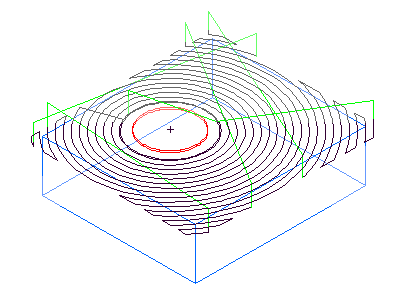
This is the same example with Min rapid distance set to 10% and the tool retracts and rapids between passes.
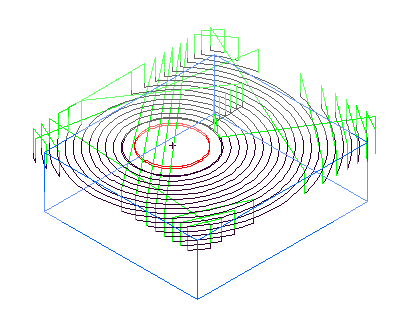
Minimum fanning— Enter the distance over which the tool can change from one ruling direction to the next.
Multiple Cuts — This enables multiple passes down the tool axis.
Multicut strategy — To use multiple cuts, first enable the Multiple cuts attribute, then select the type of strategy from the Multicut strategy list.
New Value — To change the value of an attribute in the list, first select it, then enter the new value. Click the Set button to save the new value.
Output Options — Click this button to open the Output Options dialog.
Plunge feed override % — Enter the percentage of the Feed setting to use during a plunge into the material. For example, if the Feed attribute is 2000 MMPM and you set the Plunge feed override % to 50, the resulting feed rate for the initial plunge is 1000 MMPM.
Radial offset — Enter the distance to offset the toolpath in the direction perpendicular to the tool axis. The default is zero.
|
|
|
Retract/Plunge — Click this button to open the Retract and Plunge dialog.
Set — You must click the Set button to save a New Value for the selected attribute.
Start point(s) — Override the default start point(s) of a toolpath by entering the name of a curve that, when projected, intersects the toolpath at the point you want. You can use a curve with multiple segments to set multiple start points for a toolpath, and alternating segments are used to set the start points.
Stepover rapid distance — This is used to determine whether to feed or rapid between toolpaths.
Stock overcut %
Overcut % applies to three types of surface milling features:
- spiral toolpaths designated as a boss on the stock page
- features cut with projection milling technique that do not have an explicit boundary curve
- some Z level rough passes.
In the boss case this attribute applies only to how the toolpaths behave around the stock boundary.
For other 3D surface milling features, use the cut allowance feature described on the Stock tab. The Overcut % option applies only if Use stock dimensions is selected on the feature's Stock tab.
Overcut % specifies what percentage of the tool approaches or passes beyond the stock boundary.
It can have a value between -100 and 100 with the following meanings:
0 puts the centerline of the tool on the stock curve.
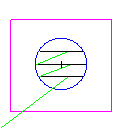
100 overcuts the region by a tool radius.
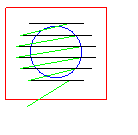
-100 stops one tool radius short of the stock curve.
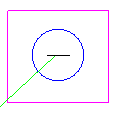
Surface join tolerance — Use this setting to enter a separate tolerance to define what represents a gap between surfaces. Sometimes the default tolerance is smaller than the gap between surfaces, and two segments of toolpath are created. To ensure one continuous toolpath across a gap, use a larger Surface join tolerance.
Target horsepower — This is the ideal [horse] power for the specified width/depth of cut and feed rate on the specified stock material type.
Tolerance — This attribute controls how accurately the toolpath follows the surface. If your part appears faceted, set the tolerance to a lower value.
Unset — Click this button to return the value of the selected attribute to its default value.
Up/Down smoothing % — Occasionally, the swarf toolpath must move up and down to avoid gouging. The smoothing happens within the tolerance you enter here. Enter a percentage of the tool diameter.
Z end — Enter the distance along the Z axis below which the operation does not mill.
Z increment — Enter the distance the tool moves down in the Z axis with each pass. This is useful if the default step down is leaving excess material on the part. When Scallop stepover is enabled, this attribute is not available.
Z start — Enter the distance along the Z axis where the milling operation starts. You can use this to save time if the stock material has already been machined away in an earlier operation.

 Trim with no radial offset
Trim with no radial offset
 Trim with
5 mm offset
Trim with
5 mm offset